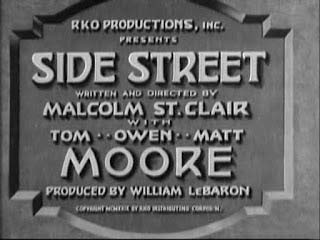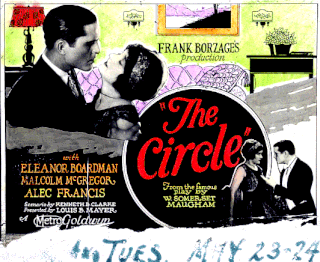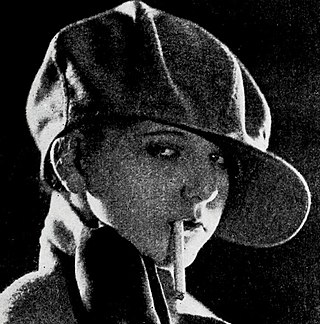
Gentlemen Prefer Blondes is a 1953 American musical comedy film directed by Howard Hawks and written by Charles Lederer. The film is based on the 1949 stage musical of the same name, which in turn is based on the 1925 novel of the same name by Anita Loos. The film stars Jane Russell and Marilyn Monroe, with Charles Coburn, Elliott Reid, Tommy Noonan, George Winslow, Taylor Holmes and Norma Varden in supporting roles.

Olive Eleanor Boardman was an American film actress of the silent era.

Mamba is a 1930 American pre-Code film, released by Tiffany Pictures. It was shot entirely in Technicolor and stars Jean Hersholt, Eleanor Boardman, Ralph Forbes, Josef Swickard, Claude Fleming, William Stanton and William von Brincken. It was based on a story by Ferdinand Schumann-Heink and John Reinhardt and was advertised as the First Drama In Natural Color as all previous color features in sound had featured musical numbers.

William Russell was an American actor, film director, film producer and screenwriter. He appeared in over two hundred silent-era motion pictures between 1910 and 1929, directing five of them in 1916 and producing two through his own production company in 1918 and 1925.

Side Street is a 1929 American Pre-Code film featuring the only screen teaming of all three Moore Brothers, each of them major silent film stars. George Raft also makes an uncredited appearance as a professional dancer — which Raft was at the time — dancing to the song "Take a Look at Her Now", sung by June Clyde. Side Street was directed by Malcolm St. Clair with a screenplay by George O'Hara and Jane Murfin, based on a story by St. Clair, which was adapted by John Russell.

The Only Thing is a 1925 American silent romantic drama film starring Eleanor Boardman. The film's scenario was written by author Elinor Glyn, and was based on a story adapted from Glyn's novel of the same name.

The Lost Princess: A Double Story, first published in 1875 as The Wise Woman: A Parable, is a fairy tale novel by George MacDonald.

Wine of Youth is a 1924 American silent comedy drama film directed by King Vidor, and released by Metro-Goldwyn-Mayer, shortly after the merger which created MGM in April 1924. Vidor did not consider it important enough to mention in his autobiography, although it did advance the careers of three young stars-to-be: Ben Lyon, Eleanor Boardman, and William Haines.

Proud Flesh is a 1925 American silent comedy-drama film directed by King Vidor and starring Eleanor Boardman, Pat O'Malley, and Harrison Ford in a romantic triangle.

So This Is Marriage is a lost 1924 American silent drama film directed by Hobart Henley. The film was originally released with sequences filmed in the Technicolor 2-color process that depicted the story of David and Bathsheba from the Book of Samuel.

The Lucky Horseshoe is a 1925 American silent Western film directed by John G. Blystone and starring Tom Mix, Billie Dove, and Malcolm Waite. Based on a story by Robert Lord, the film is about a ranch foreman who assumes responsibility for the ranch following the owner's death. He also cares for the owner's daughter who is taken to Europe by an aunt. Two year later the woman returns from Europe with her new wealthy fiancée and plans to hold their wedding at the ranch, which the foreman has turned into a successful tourist destination. The foreman's feelings for the woman have not been diminished by the years, and after learning some damaging information about the fiancée, the foreman must find a way to stop the wedding.

The Circle is a 1925 American silent romantic comedy film directed by Frank Borzage. The film stars Eleanor Boardman, Malcolm McGregor, and Alec B. Francis. A young Joan Crawford appears in the film's opening scene and later in a photograph viewed by other characters. The screenplay, written by Kenneth B. Clarke, was based on the 1921 play of the same title by W. Somerset Maugham.

The Great Meadow is a 1931 American Pre-Code Western film, produced and distributed by MGM with direction by Charles Brabin. The film starred Eleanor Boardman and Johnny Mack Brown. It is based on the novel The Great Meadow by Elizabeth Madox Roberts, which is similar in theme to Drums Along the Mohawk by Walter D. Edmonds, which was later made into the 1939 film of the same name directed by John Ford. MGM filmed The Great Meadow in a widescreen format called "Realife". However, it is unclear whether it was released in that widescreen process due to declining interest of the movie-going public.

Sally is a 1925 American silent romantic comedy film starring Colleen Moore. The film was directed by Alfred E. Green, produced by Moore's husband John McCormick, and based on the musical Sally written by Guy Bolton and Clifford Grey that was adapted to film by June Mathis. The play was a Florenz Ziegfeld Jr. production written specifically for Marilyn Miller that opened on December 21, 1920, at the New Amsterdam Theatre on Broadway. It ran for 570 performances.

The Little French Girl is a 1925 American silent drama film directed by Herbert Brenon and written by John Russell and Anne Douglas Sedgwick from a 1924 novel by Sedgwick. The film stars Mary Brian, Maurice de Canonge, Paul Doucet, Maude Turner Gordon, Neil Hamilton, Julia Hurley, and Jane Jennings. The film was released on May 31, 1925, by Paramount Pictures.

Martyrs is a 2015 American horror film directed by Kevin and Michael Goetz, and written by Mark L. Smith. The film stars Troian Bellisario, Bailey Noble and Kate Burton. A remake of Pascal Laugier's 2008 film of the same name, the story sees a woman who, after having been kidnapped and tortured as a child, goes to kill her supposed captors, and with her friend discovers the dark truth behind the torture.

Memory Lane is a 1926 American silent romantic comedy film directed by John M. Stahl and starring Eleanor Boardman, Conrad Nagel, and William Haines.

Lilies of the Streets is a 1925 American silent drama film directed by Joseph Levering and starring Virginia Lee Corbin, Wheeler Oakman, and Johnnie Walker.

Three O'Clock in the Morning is a 1923 American silent drama film directed by Kenneth S. Webb and starring Constance Binney, Edmund Breese, and Richard Thorpe. It is now considered to be a lost film.



















